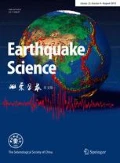Abstract
Maximum entropy deconvolution is presented to estimate receiver function, with the maximum entropy as the rule to determine auto-correlation and cross-correlation functions. The Toeplitz equation and Levinson algorithm are used to calculate the iterative formula of error-predicting filter, and receiver function is then estimated. During extrapolation, reflective coefficient is always less than 1, which keeps maximum entropy deconvolution stable. The maximum entropy of the data outside window increases the resolution of receiver function. Both synthetic and real seismograms show that maximum entropy deconvolution is an effective method to measure receiver function in time-domain.
Similar content being viewed by others
References
LIU Qi-yuan, Kind R, LI Shun-cheng. 1996. The maximum likelihood estimate and nonlinear inversion of complex spectrum ratio for receiver function [J]. Chinese J Geophys, 39(4): 502–513 (in Chinese).
Burg J P. 1972. The relationship between maximum entropy spectra and maximum likelihood spectra [J]. Geophysics, 37(2): 375–376.
Claerbout J F. 1976. Fundamentals of Geophysical Data Processing [M]. New York: McGraw-Hill, 1–357.
Owens T J, Zandt G, Talor S R. 1984. Seismic evidence for an ancient rift beneath the Cumberland Plateau, Tennesee: A detailed analysis of broadband teleseismic P waveforms [J]. J Geophys Res, 89(B9): 7 783–7 795.
Tselentis G A. 1990. Interstation surface wave attenuation by autoregressive deconvolution [J]. Pure Appl Geophys, 133(3): 429–446.
Ulrych T J, Bishop T N. 1975. Maximum entropy spectral analysis and autoregressive decomposition [J]. Rev Geophys Space Phys, 13(1): 183–200.
Ulrych T J, Clayton R W. 1976. Time series modeling and maximum entropy [J]. Phys Earth Planet Inter, 12(2/3): 188–200.
Van den Bos A. 1971. Alternative interpretation of maximum entropy spectral analysis [J]. IEEE Trans Inform Theory, 1T-17: 493–494.
Author information
Authors and Affiliations
Additional information
Foundation item: State Natural Science Foundation of China (49974021).
Contribution No. 03FE1011, Institute of Geophysics, China Seismological Bureau.
About this article
Cite this article
Wu, Qj., Tian, Xb., Zhang, Nl. et al. Receiver function estimated by maximum entropy deconvolution. Acta Seimol. Sin. 16, 404–412 (2003). https://doi.org/10.1007/s11589-003-0073-y
Received:
Revised:
Accepted:
Issue Date:
DOI: https://doi.org/10.1007/s11589-003-0073-y




